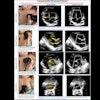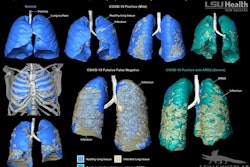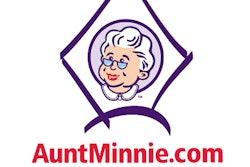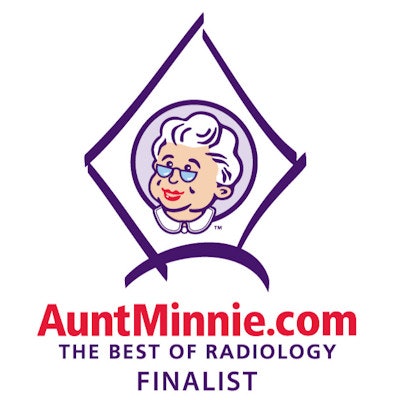
Are you curious about who made it to the final round in the 20th edition of the Minnies, AuntMinnie.com's event recognizing excellence in radiology? This year's list of finalists includes some familiar faces, as well as some newcomers.
The Minnies finalists were drawn from more than 200 candidates in 14 categories, ranging from Most Influential Radiology Researcher to Best Educational Mobile App. To see the full list of candidates, click here.
In the next round of voting, our expert panel will vote on the finalists, with winners announced in October.
Most Influential Radiology Researcher
Dr. Michael Recht, NYU Langone Health
 Dr. Michael Recht.
Dr. Michael Recht.As chair of the radiology department at NYU Langone Health since 2008, Dr. Michael Recht continues to actively pursue research, particularly in his subspecialty of musculoskeletal radiology.
Recht has been the lead or senior author on a number of important papers in 2019, with a special focus on socioeconomic issues such as workflow optimization and preventing physician burnout, as well as using imaging informatics technologies to improve radiology efficiency.
For example, Recht authored a paper published in the April edition of the American Journal of Roentgenology that described how NYU Langone Health optimized its MRI workflow with dockable patient tables, dedicated MRI preparation rooms, and the duplication of commonly used coils, improving turnaround time by five minutes per patient. The study was nominated for a Minnies award in the Scientific Paper of the Year category.
In another paper on which Recht was senior author, researchers from NYU Langone described their use of "expeditors" to speed up workflow in the CT suite. The expeditor was stationed at the hospital's emergency department (ED) and was responsible for facilitating CT orders by communicating with ED providers and coordinating the workup of patients. The expeditors helped reduce turnaround time by 35%, the researchers found.
Recht also delivered an oration after the president's address at RSNA 2018. In his talk, he discussed how new technology such as virtual consults and mobile apps could help radiologists return to their role as the central player on the critical care team -- in other words, the doctor's doctor.
And Recht hasn't restricted his activities to research: He has also participated actively in education, such as helping found the National Imaging Informatics Curriculum and Course (NIIC), a weeklong course that combines online and in-person learning that is designed to introduce fourth-year radiology residents to the world of imaging informatics.
Dr. Barry Siegel, Washington University School of Medicine
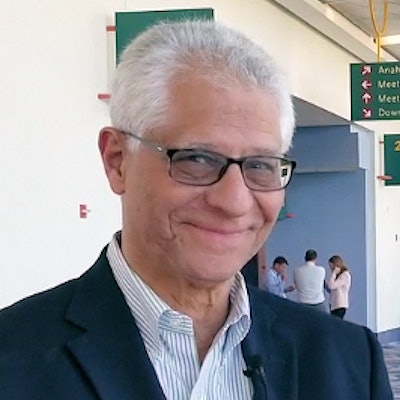 Dr. Barry Siegel.
Dr. Barry Siegel.Dr. Barry Siegel is a titanic figure in nuclear medicine. His achievements and reputation in the field are such that in 2019 the Society of Nuclear Medicine and Molecular Imaging (SNMMI) named a lecture after him -- with Siegel delivering the inaugural talk.
Much of Siegel's research has focused on PET, where he has not only led clinical studies but also has been active in trying to secure Medicare reimbursement for the modality. Thanks in part to his efforts, PET has grown from a cottage industry into a major imaging modality that stands shoulder to shoulder with x-ray, CT, and MRI.
In 2019, his research work has continued to focus on PET, from a study published in August on FDG-PET for detecting metastases from cervical cancer to his involvement in the Evidence for Amyloid Scanning (IDEAS) study. The latter is important research into the use of amyloid PET radiopharmaceuticals to detect early signs of Alzheimer's disease, published April 2 in the Journal of the American Medical Association.
Other work by Siegel has investigated the use of PET with an F-18 fluciclovine radiopharmaceutical to detect the biochemical recurrence of prostate cancer. He has also studied the use of molecular imaging to help guide treatments such as radiation therapy and chemotherapy.
Siegel continues to work as chief of the division of nuclear medicine at Washington University School of Medicine in St. Louis, the same institution from which he received his medical degree in 1969.
Most Effective Radiology Educator
Dr. Emanuel Kanal, University of Pittsburgh
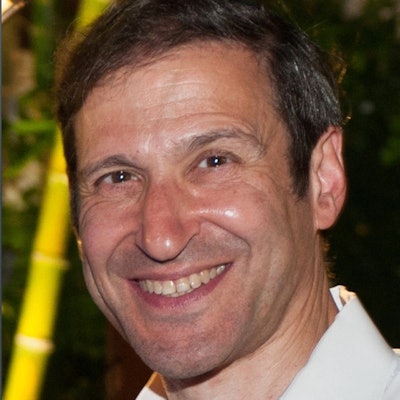 Dr. Emanuel Kanal.
Dr. Emanuel Kanal.Dr. Emanuel Kanal has long been known as one of the leading experts on MRI safety. But his profile has risen even higher in recent years due to ongoing concerns over important issues such as gadolinium deposition from MRI contrast agents and the safety of magnetic fields from MRI scanners.
Kanal's day job is at the University of Pittsburgh, where he is director of MR services, but he also runs educational courses with a special focus on MRI physics.
His involvement in MRI safety includes activities such as testifying to U.S. Food and Drug Administration committees and serving on the American College of Radiology's MR safety panel. He also founded the American Board of Magnetic Resonance Safety (ABMRS), which offers certification and credentialing to professionals who pass written exams.
In 2017, he unveiled MagnetVision, a novel new mobile app that demonstrates where magnetic fields are the strongest when scanning patients -- a feature that can help MRI technologists when working with patients.
Gadolinium deposition from MRI contrast is an issue that Kanal has followed closely. Residual levels of gadolinium have been discovered in patients, in some cases years after they received MRI scans, and some patients claim they have sustained debilitating injuries after receiving gadolinium contrast.
Dr. Tan-Lucien Mohammed, University of Florida
 Dr. Tan-Lucien Mohammed.
Dr. Tan-Lucien Mohammed.Radiology residency can be a perilous journey. Fortunately, there are educators like Dr. Tan-Lucien Mohammed who are available to help residents find the path.
Mohammed is vice chair of education and chief of thoracic imaging at the University of Florida. He's particularly active in online forums and on social media, providing guidance to medical students and residents alike on making the most of their educational experience.
A four-time Minnies nominee, Mohammed's teaching has also been acknowledged with awards from the University of Florida and from the Cleveland Clinic, where he served as a staff radiologist from 2004 to 2012.
Mohammed's research work over the past year has covered both educational and clinical issues. He co-authored a paper on the value of persuasive skills for radiologists in the Journal of the American College of Radiology, while his clinical publications have included pulmonary sarcoma and FDG-PET for pulmonary lesions. He even co-authored a report on a rare case of hypersensitivity pneumonitis due to Florida red tide, published in Case Reports in Pulmonology.
Most Effective Radiologic Technologist Educator
Tobias Gilk, Gilk Radiology Consultants
 Tobias Gilk.
Tobias Gilk.Like Dr. Emanuel Kanal, Tobias Gilk is a well-known speaker and educator on MRI safety, with a particular focus on helping MRI facilities avoid accidents that could pose a threat to patient safety.
As both a senior vice president of RAD-Planning and founder of Gilk Radiology Consultants, Gilk delivers presentations and holds seminars on MRI safety for providers of MRI services, while also offering consulting services to scanner developers on the U.S. Food and Drug Administration's rules on MRI-conditional devices.
Gilk's consulting services range from contemporary regulatory changes to new MRI technology to data-driven results of MRI safety accidents and injuries. Like Kanal, he has been involved as an officer in the American Board of Magnetic Resonance Safety. He also founded the MRI Safety Group forum, the largest community dedicated exclusively to MRI safety clinical questions and solutions.
Colleen Dempsey, Thomas Jefferson University
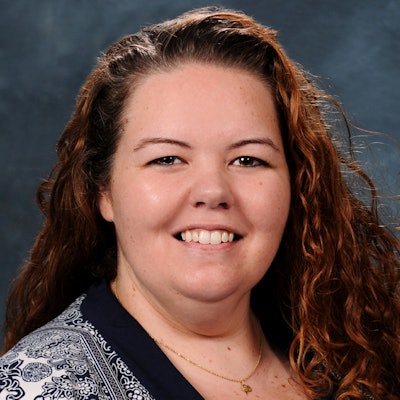 Colleen Dempsey.
Colleen Dempsey.Thomas Jefferson University (TJU) runs one of the most well-regarded radiologic technologist training programs in the U.S., so it's no surprise that Colleen Dempsey, EdD -- currently program director of the university's radiography program -- made it to the finalists' round in the Minnies.
Two years ago, Dempsey took over as program director and interim chair of the department from Frances Gilman, who had run the program since 2003. Gilman was a Minnies winner in 2017 in the Most Effective Radiologic Technologist Educator category.
Dempsey has been working at Thomas Jefferson University for the past 11 years, first as a clinical instructor for eight years before becoming program director (she served one year as acting program director). She was also a radiography technologist at Mercy Health System of Southeastern Pennsylvania for 12 years before coming to TJU.
She holds a doctorate in education from Gwynedd Mercy University, as well as a master's degree in radiologic and imaging science from TJU.
Most Effective Radiology Administrator/Manager
Chris Tollefson, Mayo Clinic Arizona
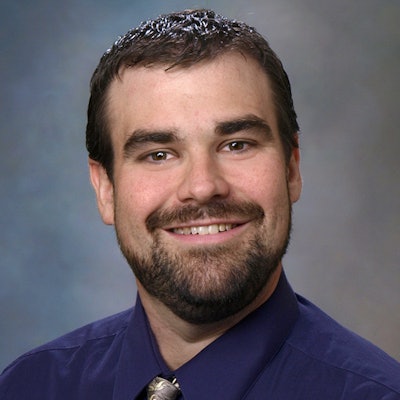 Chris Tollefson.
Chris Tollefson.As radiology operations manager at the Mayo Clinic in Arizona, Chris Tollefson is responsible for running the business side of medical imaging at the prestigious Mayo facility.
Tollefson has been in the role over the past year, although he's worked at Mayo for more than 19 years. His previous roles at Mayo have included managing the department's informatics/physics operations, including its PACS, postprocessing, and analytics platforms.
He was also nuclear medicine supervisor for seven years at Mayo, from 2008 to 2015, and prior to that he served in different roles as a nuclear medicine technologist. He is also a member of the Arizona Radiation Regulatory Hearing Board, which regulates the use of radiation in the state.
Greg Hill, Emory University
 Greg Hill.
Greg Hill.As executive administrator and vice chair of administration, Greg Hill is responsible for overseeing the operations of Emory University's radiology department.
Hill joined Emory in November 2018, after previously serving as lead department administrator in radiology for four years at the Medical College of Wisconsin. Before joining the radiology department, he was lead administrator for the pathology department as well as the university's Center for Imaging Research.
Hill's experience goes beyond academic medicine, however. He has also served as CEO and chief operating officer at Central Illinois Radiological Assoc., a private-practice radiology group.
Best Radiologist Training Program
In 2018, the duel between Best Radiologist Training Programs in the Minnies pitted two schools from Northern California: Stanford University and the University of California, San Francisco. In 2019, the competition shifts to the South, where Duke University of Durham, NC, faces off against Emory University of Atlanta.
Duke University, Durham, NC
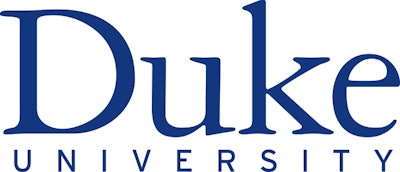
Resident education is a major priority at Duke Radiology. The program nearly 20 years ago was the first to adopt a 3/2 curriculum, in which three years of rigorous training in general diagnostic radiology is followed by the option of two years of subspecialty training, which includes a flexible fourth year.
The 3/2 program provides for almost 10 months of protected research time during the R4/PGY-5 year, and Duke encourages residents to use this time for "vigorous and novel" intellectual exploration. Research projects in the 3/2 program often feature collaboration between clinical and basic science departments.
The R4/PGY-5 year can also be used to finish Duke's Early Specialization in Interventional Radiology (ESIR) program or a 16-month dual-certification pathway in diagnostic radiology and nuclear medicine. Other possibilities for residents include working with the Duke Global Health Institute on a global health elective or even a minifellowship.
The overall goal of the 3/2 program is to produce radiologists who have a grounding in general diagnostic radiology but who also have subspecialty expertise, while the customization possible with the R4 year allows residents to be more competitive radiologists when they graduate.
Duke's diagnostic radiology residency program is led by program director Dr. Karen Johnson, while the chair of Duke's radiology department is Dr. Erik Paulson. Duke previously won the Minnie award for Best Radiologist Training Program in 2001.
Emory University, Atlanta, GA

Emory University's reputation in radiology has been on the rise in recent years, and the department of radiology and imaging sciences hopes to build on that reputation with its Designing the Destination strategy.
Emory's radiology residency program emphasizes its diversity and the positive attitude of its residents, as well as the collegial and collaborative environment at the university for working and learning. While education is the major priority at Emory, radiologists from the department also perform cutting-edge research, particularly on issues such as disparities in healthcare utilization and the appropriate use of healthcare resources.
Emory's goal in educating residents is to train them to be skilled diagnosticians as well as to mold them into well-rounded radiologists who will also be ethical leaders, according to the department.
The program director of the radiology residency program is Dr. Christopher Ho, while the chair of Emory's radiology department is Dr. Carolyn Meltzer. Should Emory be named Best Radiologist Training Program in this year's Minnies competition, it would be the department's first Minnies win in the category since the competition began in 2000.


